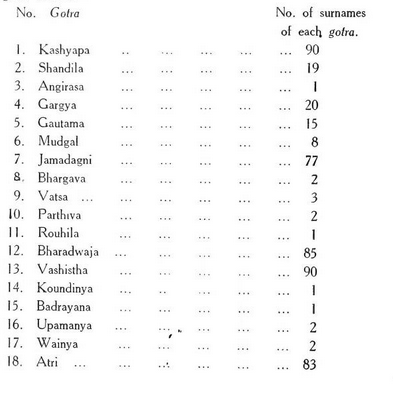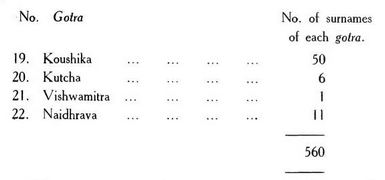Brahman-Karhadas: Deccan
Contents |
Brahman-Karhadas
This article is an extract from THE CASTES AND TRIBES OF H. E. H. THE NIZAM'S DOMINIONS BY SYED SIRAJ UL HASSAN Of Merton College, Oxford, Trinity College, Dublin, and Middle Temple, London. One of the Judges of H. E. H. the Nizam's High Court of Judicature : Lately Director of Public Instruction. BOMBAY THE TlMES PRESS 1920 Indpaedia is an archive. It neither agrees nor disagrees |
Karhadas, Karhatakas — receive their name from the town of Karhad; situated on the confluence of the Krishna and Koyana rivers, in the Satara_ District of the Bombay Presidency. Their earliest settlement is said to have extended from the town of Karhad in the south to the river Vedawati in the north (Sah\}adri Khand Adh. 2). It was from this tract that the Karhadas appear to have spread over different countries and are now found in considerable numbers in the Konkan, Kolhapur, Bombay, Zansi, Indore and Hyderabad.
Origin
The Karhadas seem to be an offshoot from the Des- hastha Brahmans, separated from the main stock in far early times. In the Sahydari Khdnd of Skandha Pumna and in the Uttar Khand of the Karhadas are said to have been
Brahmdnd Purdna (Adh. 11) made by Parshuram from a camel's bone, and are accused of carrying out horrid practices. The author of the Sahyddri Khdnd, who showed hostile feelings towards all rival sub-castes, no doubt based this legend upon the absurd derivation of the wotd Karhad from kara or karabha — camel, and had — bone. According to another account, they are believed to be descended from a disciple of Parshuram, who was enjoined by his master to bring flowers of Karhataka (dhotra) daily for the worship of Nilkanth (the blue-necked Shiva). The regular performance of his duty procured him the nickname, Karhataka, which was subsequently transmitted to nosterity and became the designation of the sub-caste.
Internal Structure
The Karhada Brahmans are sub-divided into 22 exogamous groups, or gotras, which comprise more than five hundred families (surnames). A list of these gotras is given below : —
These exogamous sections are eponymous in character, the eponym being the name of a Vedic saint or Rishi.
Intermarriages are forbidden between families not only bearing the same gotra but also bearing the same pravara. Sapmda rela- tions (agnates), extending to seven degrees, are also avoided in marriage. Marriage with a maternal uncle's daughter is allowed by the caste. The three sub-castes, Deshasthas, Konkanasthas and Karhadas, were formerly strictly endogamous : but with the spread of western education this rigidity of the caste bond is being slackened, and instances of intermarriages between their members are of frequent occurrence at the present day.
Religion
The Karhadas are all Rigvedis of the Shukla Shakhas, who respect the sutra, or aphorism, of Ashwalayana. They belong to both the Smartha, and Vaishnava sects, and in religious and spiritual matters follow the guidance of Shri Shankaracharya, and Madhwacharya, respectively. Their titulary deity is Mahalaxmi, or Ambabai, of Kolhapur. They also pay reverence to Shanta Durga, Mhalsa, Aja Durga, Vijaya Durga, and other local divinities. It is believed that a few of the Karhadas are Shakti worshippers and offered, in ancient times, human sacrifices to Matrika and Lalita, two terrible forms of Shaktis. The blood-thirsty goddess claimed a son- in-law as the proper victim but, if one was not available, any stranger of the Brahman caste was allowed. The ill-fated Brahman was lured into confidence, poisoned on the special day appointed for the worship and, while in his death pangs, was sacrificed at the altar of the goddess. The following is an extract from a narrative com- municated to Sir John Malcolm by a Karhada friend in 1799 A.p.
The Shakti is supposed to delight in human blood and is represented by three fiery eyes and covered with red flowers. This goddess holds a sword in one hand and a battle axe in the other. The prayers of her votaries are directed to her during the first nine days and on the evening of the 10th day a grand repast is prepared, to which the whole family is invited. An intoxicating drug is contrived to be mixed with the food of the intended victim, who is often a stranger whom the master of the house has for several months, perhaps years, treated with the greatest kindness and atten- tion and, sometimes, to lull suspicion, given him his daughter in marriage. . As soon as the poisonous and intoxicating dri^g operates, the master of the house, unattended, takes the devoted person into the temple and leads him three times round the idol ; on his prostrating himself before it, the opportunity is taken of cutting his throat. The blood having been collected with the greatest care in a small bowl, is first applied to the lips of this ferocious goddess and then sprinkled over her image ; a hole having been dug at the feet of the idol for the corpse, it is deposited with great care to prevent discovery.
After perpetration of this horrid act, the Karhada Brahman returns to his family and spends the night m mirth and revelry, convinced that by this praiseworthy act he has propitiated the favour of his blood-thirsty deity for twelve years. On the morning of the follow- ing day, the corpse is taken from the hole in which it had been thrown and the idol is put away till the following Dassera festival, when a similar sacrifice is made. The discontinuance of this horrid custom in recent years is said to have principally arisen from the following circumstance : — At Poona, a young and handsome Carnatic Brahman, fatigued with travel and oppressed by the scorching heat of the sun, sat himself down in the verandah of a rich Brahman who chanced to be of the Karhada sect. The Brahman shortly after passed by and, perceiving that the youth was a stranger, invited him to his house, and requested him to remain till perfectly recovered from the fatigues of his journey. The unsuspecting Brahman youth readily accepted this apparently kind invitation and was several days treated with so much attention and kindness that he showed no inclination to depart. He had seen also the Karhada Brahman's beautiful daughter and conceived a violent attachment for her. Before a month had elapsed he had asked and obtained her in marriage. They lived happily together till the time of the Dassera arrived, when the deceitful old Brahman, according to his original intention, determined to sacrifice his son-in-law to the goddess of his sect. Accordingly, on the tenth day of the feast, he introduced an intoxicating poisonous drug into his son-in-law's food, not, however, unperceived by his daughter. She, being passionately fond of her husband, contrived, unobserved, to exchange this dish for that of her brother, who in a short time became senseless. The unhappy Brahman, despairing of his son's recovery, carried him to the temple, put him to death with his own hands and made to his idol an offering of his blood. The young Brahman, perceiving this, and alarmed for his own safety, effected his escape and related the whole affair to the Peshwa. The infamous perpetrator with others was seized and put to death." (Trans, of Bombay L. Society, Vol. Ill, pp. 86-87.) Major Moore, in his " Hindu Infanticide," (pp. 196-198), refers to three instances of human sacrifice brought to his notice by Vishnupant, a Karhada Brahman.
This horrid custom, which was confined to only a few Karhada families of Shakti worshippers, has probably been totally abandoned, as no instances of its occurrence have been recorded for many years. The Karhada Brahmans are remarkable for their neat and cleanly habits and hospitable conduct. They are a very intelligent class and have risen to high offices under the present Government. The poet Mpropant and the notoriously brave Rani Laxmibai of Zansi belonged to this caste.

